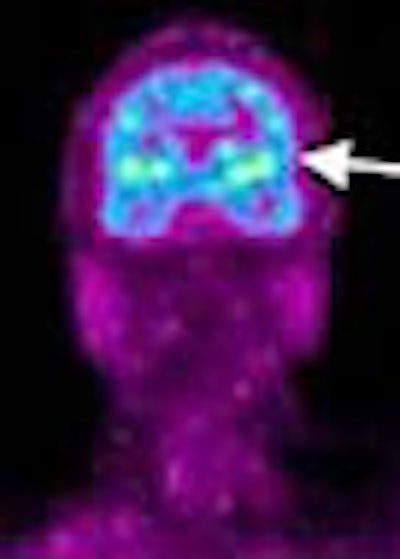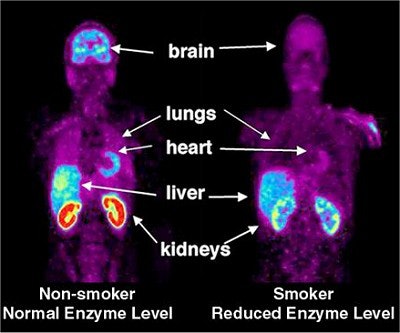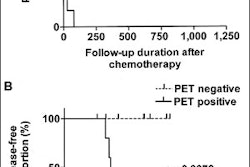
Monoamine oxidase B (MAO B) enzyme levels in the kidneys, heart, lungs, and spleen are significantly reduced by smoking, researchers at the U.S. Department of Energy's Brookhaven National Laboratory report in the early edition of the Proceedings of the National Academy of Sciences.
"We need to look beyond nicotine to fully appreciate the effect of smoking on human health. Medical issues associated with smoking need to now be considered in relationship to the systemic effects of reduced MAO B," said lead researcher Jane Fowler, Ph.D., a research chemist at the Brookhaven National Laboratory in Upton, NY.
MAO B is involved in the chemical process of neurotransmission and in breaking down blood pressure-elevating chemical compounds founds in common foods.
The group administered the MAO B-specific binding radiotracers (labeled with carbon-11) to 12 smokers, who underwent whole-body PET scans. PET images were compared with scans from eight nonsmokers. The group found that MAO B in the heart, lungs, kidneys, and spleen was reduced by 33%-46% in smokers compared to non-smokers (PNAS, September 8, 2003).
 |
| The illustration shows the concentration of radioactive tracer bound to monoamine oxidase B (MAO B). Red shows the highest concentration. Clearly, lower concentrations are seen in the smoker. In certain areas, such as the lungs and brain, concentrations are so low as to be virtually absent. This demonstrates decreased amounts of MAO B in the peripheral organs of smokers compared to non-smokers. Proceedings of the National Academy of Sciences, September 8, 2003, "Low Monoamine Oxidase B in Peripheral Organs in Smokers." |
"Although the emphasis on the health effects of smoke has been placed on the lungs and the upper airways, this finding highlights the fact that multiple organs in the body are exposed to pharmacologically significant quantities of chemical compounds in tobacco smoke," Fowler and colleagues wrote.
Commenting on the study, Dr. Raymond Orbach described Fowler’s results as groundbreaking. "With the new radiotracers we are developing, for the first time we shall be able to understand the abnormal metabolism of the brain and other organs in a wide range of disease states," said Orbach, who is the director of the Office of Science at the U.S. Department of Energy.
Fowler said the next step would be to see if smokers have reduced levels of MAO A as well as MAO B (each subtype of enzyme breaks down different substances in the body). They also will look at variations in MAO genes and their impact on MAO levels in the brain.
By Bruce SylvesterAuntMinnie.com contributing writer
September 11, 2003
Related Reading
European smokers will see images of lung disease, September 8, 2003
Low-dose CT scanning cost effective in lung cancer screening, September 4, 2003
Mortality from four leading cancers continues to fall in U.S., September 3, 2003
Pairing of CT and PET scans may aid early lung cancer detection, August 22, 2003
Copyright © 2003 AuntMinnie.com




















